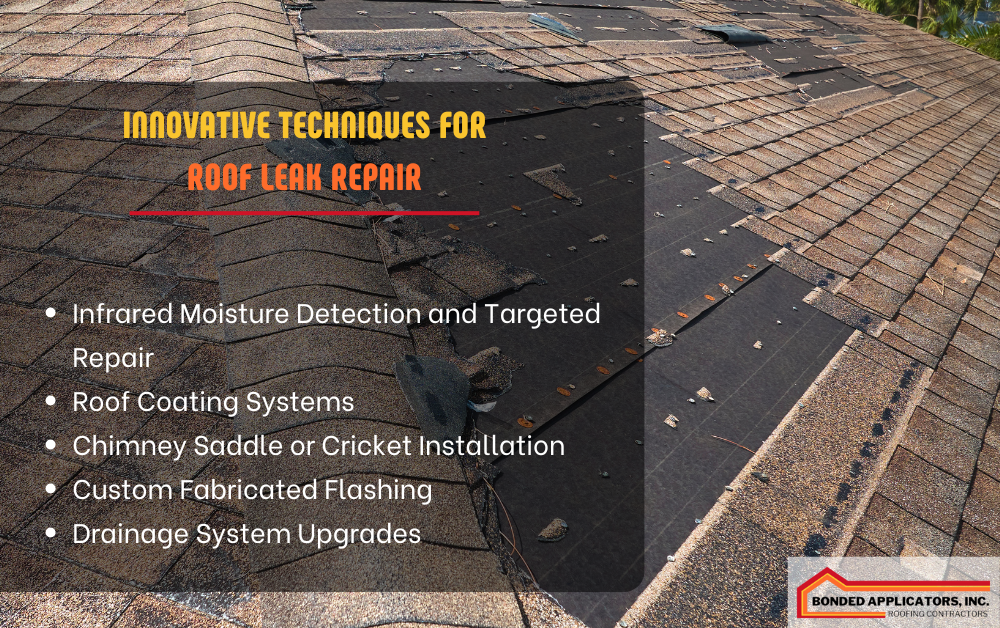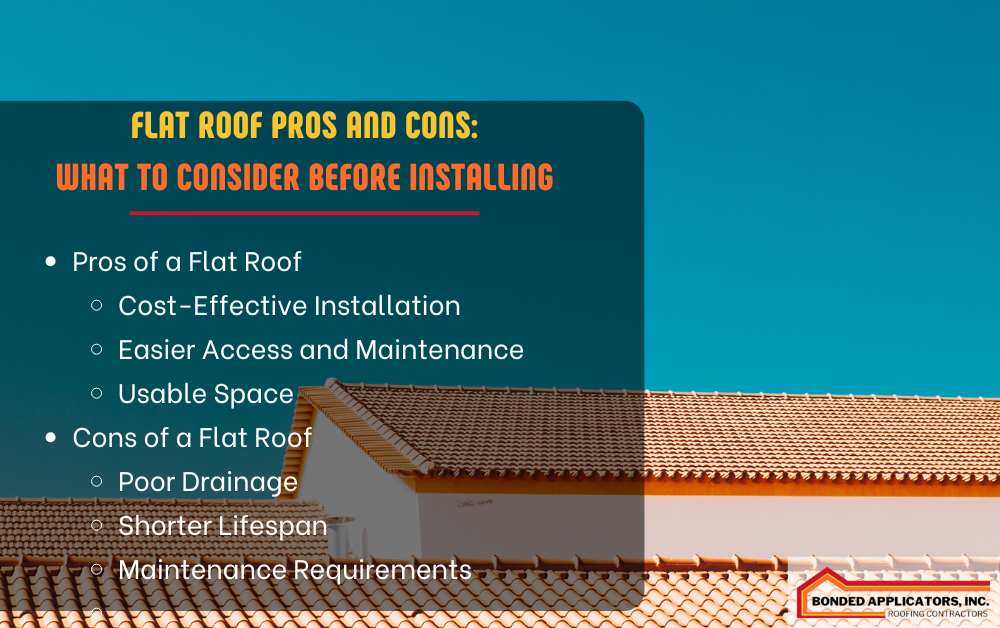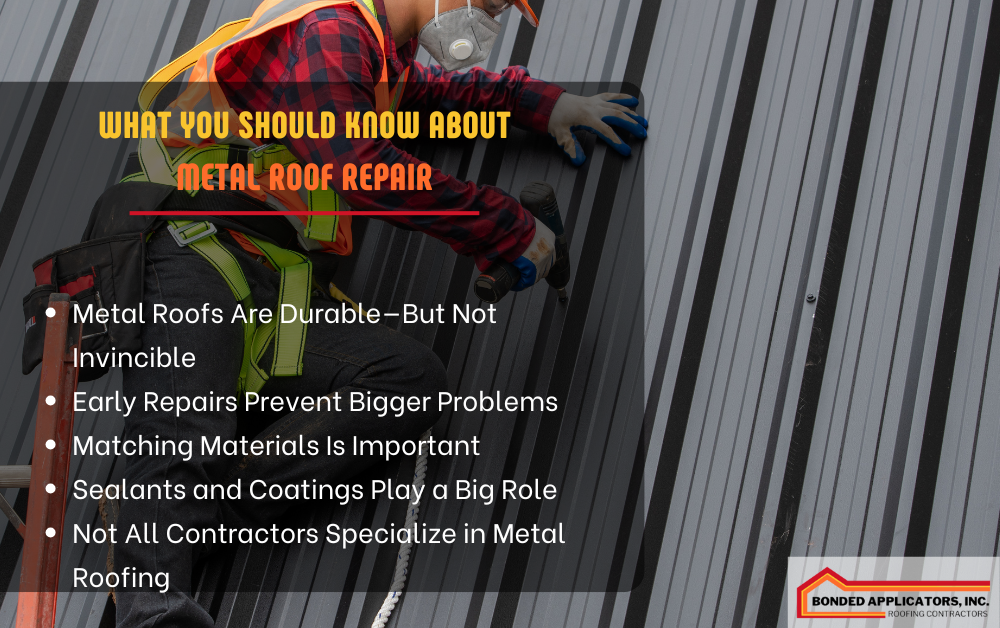Roof leak repair isn’t always a matter of patching a few shingles or applying sealant. Some roofing problems require a more advanced and strategic approach, especially when the source of the leak is hidden or in a vulnerable area. That’s why property owners turn to experienced professionals like Bonded Applicators for specialized, practical solutions. With modern tools and techniques, they provide long-lasting repairs that protect both your roof and the structure beneath it. In this blog, we’ll break down five unique methods that go beyond traditional fixes. Each offers a targeted way to restore roof integrity with minimal disruption.
Infrared Moisture Detection and Targeted Repair
Finding Hidden Moisture with Precision
Infrared moisture detection is a highly accurate method that uses thermal imaging to detect water hidden beneath roofing materials. This approach is especially valuable when the leak source isn’t visibly apparent from the roof’s surface. By identifying the precise location of moisture, roofers can avoid unnecessary demolition or guesswork. This targeted process not only saves time but also reduces repair costs. It’s ideal for both residential and commercial roofs where the structure must be preserved. Roof leak repair using this technology leads to efficient and less invasive solutions.
Minimizing Roof Disruption
Traditional repair methods often involve tearing up large portions of the roof to locate the leak. Infrared detection eliminates that need by highlighting exact wet zones, reducing the area that needs repair. This means less mess, less time on site, and a faster return to a fully functioning roof. This has advantages for both residential and commercial property owners. The technology enables more accurate repairs, preserving your existing materials. It’s a proactive way to address roof damage without excessive disturbance.
Efficient, Cost-Effective Repairs
Because this method narrows down the affected area, only the necessary repairs are made. This leads to lower material and labor costs compared to full-section replacements. By addressing moisture early, you can also prevent further internal damage like rot or mold. It’s an investment that pays off by extending your roof’s lifespan. Infrared detection provides both short-term solutions and long-term protection. For targeted roof leak repair, it’s one of the most valuable tools available today.
Roof Coating Systems
Seamless Waterproofing for Flat Roofs
Roof coatings are especially effective on flat or low-slope roofs where water pooling is more common. These liquid-applied coatings form a seamless, waterproof membrane that eliminates joints and gaps. Silicone and acrylic are popular options because of their robust construction and shielding from ultraviolet rays and weather damage. Once cured, the coating creates a continuous surface that prevents leaks and reflects sunlight. This not only protects your roof but also improves energy efficiency. This is a strategic solution designed to avoid roof leaks and minimize long-term damage.
Extending Roof Lifespan
Instead of replacing an entire roof section, coating systems offer a less invasive alternative. They can be applied to aging roofs that still have structural integrity but show early signs of wear. With proper preparation, the coating adheres tightly and provides years of added performance. It’s a cost-effective way to postpone complete replacement and improve roof reliability. Coatings can also reduce thermal shock by reflecting heat and stabilizing rooftop temperatures. In many cases, this adds up to a longer-lasting, better-performing roof.
Costly Damage Prevention
Roof coatings stop minor issues like small cracks or pinholes from turning into major leaks. These small imperfections can be difficult to detect until it’s too late. A high-quality coating acts as a preventative layer, sealing these trouble spots before they cause interior damage. In climates with extreme sun or rain, coatings provide extra protection against rapid deterioration. Maintenance needs are minimal, and reapplication every few years can keep your roof in great shape. This makes coatings a practical, long-term roof leak repair option.
Chimney Saddle or Cricket Installation
Redirecting Water Around Chimneys
Chimneys can be vulnerable points in a roof’s waterproofing system, especially in the space where the chimney meets the roof surface. Water tends to collect behind chimneys, increasing the risk of seepage and decay. A chimney saddle, also known as a cricket, is a small, angled structure installed behind the chimney to divert water. This redirection prevents pooling and helps water drain off the roof correctly. It’s a small structural change that makes a big difference in moisture management. Installing a cricket is a proactive roof leak repair step that can prevent future damage.
Structural Enhancement Behind the Chimney
Chimney crickets are usually built to match the roof’s pitch and material for a clean and functional appearance. They provide support and reinforcement in a high-risk area of the roof. Without a cricket, water can remain trapped for extended periods, accelerating wear and tear. The added slope from the cricket ensures that rainwater doesn’t have time to settle or leak in. It’s a strategic improvement that boosts both aesthetics and function. This method is critical in areas with frequent rain or snow.
Preventing Future Leaks
Once installed, a chimney saddle significantly lowers the risk of repeat leaks in that area. This type of repair is long-lasting and typically requires very little maintenance afterward. It’s beneficial for older homes where water has been an ongoing issue. While it might need some customization, the results speak for themselves in long-term leak prevention. Roofing professionals like Bonded Applicators use this method to improve drainage and ensure durability. It’s a wise investment in your roof’s future stability.
Custom Fabricated Flashing
Tailoring Flashing to Unique Roof Features
Not all roof structures are standard, and unique shapes often call for custom solutions. Custom-fabricated flashing is designed to fit complex architectural features like curved walls, domes, or unusual vents. Factory-made flashing usually fails to provide full coverage, leading to small gaps where leaks can form. With custom metalwork, every angle and transition is accounted for. This type of precision ensures a watertight seal around vulnerable areas. It’s a highly specialized roof leak repair method with long-term reliability.
Precision Sealing Around Penetrations
Penetrations such as chimneys, skylights, and HVAC units are standard leak zones. If flashing around these features isn’t installed correctly, water can seep underneath. Custom flashing is shaped and sealed specifically for each penetration to eliminate weak points. It provides a more accurate fit than off-the-shelf materials, reducing the chance of failure. When installed by skilled professionals, it blends seamlessly into the roofline. This method enhances both performance and appearance.
Eliminating Hard-to-Fix Leaks
Leaks around complex roof components can be tricky to resolve with standard materials. Custom flashing gives contractors the ability to address those problem areas with tailored solutions. This not only stops current leaks but also helps prevent future ones in the exact location. The durability of metal flashing also makes it a long-lasting option, even under harsh weather conditions. It’s ideal for homes with detailed roof architecture. When precision matters, custom flashing provides a superior solution.
Drainage System Upgrades
Improving Rainwater Flow
Sometimes, roof leaks result not from roof material failure but from inadequate drainage systems. When gutters, scuppers, or internal drains are missing or blocked, water pools on the roof and eventually penetrates the surface. Upgrading these systems ensures that rainwater is directed away from vulnerable areas. Proper water flow helps preserve the roof’s structure and extend its life. In many cases, simply improving drainage can eliminate ongoing leaks: it’s an innovative and sustainable form of roof leak repair.
Adapting to Roof Slope and Runoff
Each roof is different, and drainage must be tailored to the slope, size, and surrounding environment. Installing new gutters, adding downspouts, or modifying the roof’s pitch can all improve runoff. These adjustments help move water off the roof quickly, reducing standing water and its associated risks. By managing water more effectively, you also reduce the load on other parts of the roof. Roofing professionals analyze these details to create an efficient drainage plan. This proactive approach protects your roof and reduces future repair needs.
Eliminating Leak Triggers
Addressing drainage issues is one of the best ways to stop leaks at the source. By improving water flow, you eliminate one of the most common causes of roofing damage. These upgrades are significant in climates with heavy rainfall or snow. They can be completed quickly and make a big difference in your roof’s performance. With proper maintenance, these changes can extend your roof’s life by many years. As part of a comprehensive roof leak repair plan, drainage improvements are highly effective.
Conclusion
Roof leak repair has evolved far beyond basic patch jobs. With modern options like infrared detection, seamless coatings, chimney crickets, custom flashing, and improved drainage systems, today’s solutions are more innovative and more durable than ever. Bonded Applicators brings these advanced techniques to homeowners who want long-lasting protection and efficient service. By addressing the root causes of leaks with precision, they help you safeguard your property for years to come. Don’t wait for a small leak to turn into significant damage. Contact Bonded Applicators today to schedule expert roof leak repair and keep your home secure, dry, and protected.




